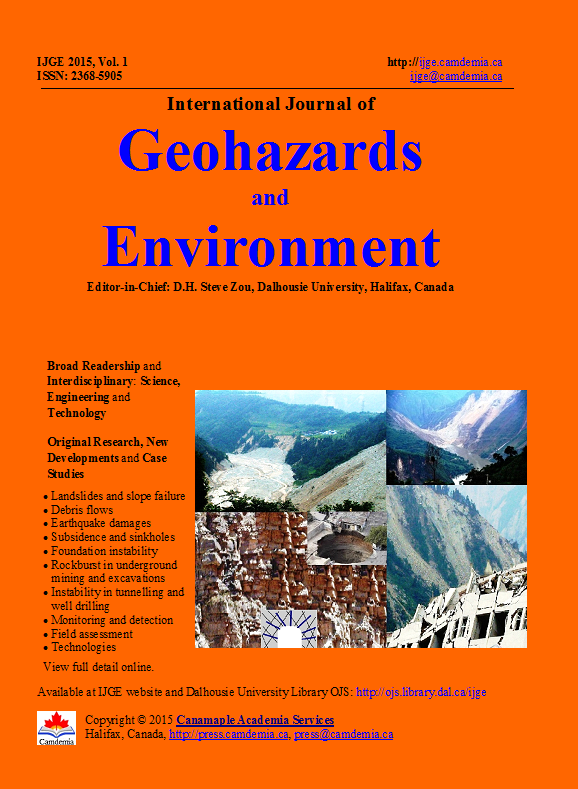Large Lateral Deformation Characteristics of Simulated Columnar Jointed Rock Mass under Uniaxial Compression Tests
Keywords:
rock mechanics, columnar jointed rock mass, lateral strain ratio, uniaxial compression testAbstract
The columnar jointed rock mass is a common structure in extrusive igneous rocks. Due to the columnar joints network, large lateral deformation may result from slipping along these columnar joints and the corresponding lateral strain ratio may greatly exceed the upper limit of Poisson's ratio. Correct understanding of the large lateral deformation characteristics of columnar jointed rock mass is essential to the design of tunnels and underground caverns where the uniaxial compression condition usually occurs. Therefore, in order to perform uniaxial compression tests, simulated columnar jointed rock mass specimens with different dip angles were prepared using plaster mixtures, and the curve of variation of lateral strain ratio to dip angle was obtained. The shape of the curve resembles as inverted U-typed and the maximum of lateral strain ratio occurs at β = 30°. The mechanism of large lateral deformation is explained in light of the dip angle and failure modes, and an experimental equation is presented to predict the variation of lateral strain ratio to dip angle.Downloads
Issue
Section
License
Copyright, Terms and Conditions
The International Journal of Geohazards and Environment (the Journal) is published by Canamaple Academia Services (the Publisher) online with open access, under a Creative Commons Attribution-Noncommercial license (CC-BY-NC) (http://creativecommons.org/licenses/by-nc/4.0/). Authors (the Authors) submitting papers (the Work) for publication in the Journal automatically agree to the following terms and conditions.
1. Under the license (CC-BY-NC), Authors give permission for others to share and reuse the Work, as long as the original source and author(s) are properly cited (i.e. a complete bibliographic citation and link to the Journal website) and the material is not used for commercial purposes. Any sharing or reuse must however indicate the original CC-BY-NC license terms of the work.
2. Authors transfer and assign to the Publisher all copyright in and to the Work. However Authors retain all proprietary rights except the copyright, related to the Work and also retain the rights a) to use, reproduce, distribute, and publicly display the Work in any medium in connection with the Authors‘ academic and professional activities, such as teaching, presentations and lectures, b) to create derivative works from the Work and to make full use of the Work in future research and publications, c) to authorize others to make any non-commercial use of the Work, d) to make both the pre-published and final-published versions available online in institutional and/or disciplinary repositories or on their own websites with a citation and link to the original paper published in the Journal.
3. Authors warrant that the Work is their original work, it is not copied from anywhere or anyone else, they are totally responsible for the authenticity, originality, validity and accuracy, and the facts and views are their own, that the Work contains no matter which is defamatory or infringes any literary or proprietary rights, intellectual property rights, or any rights of privacy, and that the Work has not been simultaneously submitted to any other journals or publishers. Authors further agree that their manuscripts whether accepted or rejected will not be returned and the rejected manuscripts will be disposed at the journal editor's discretion.
Disclaimer: The Publisher, the Journal and the editors accept no responsibility for statements or opinions expressed by authors. Use of information and materials in the Journal is the sole responsibility of users.


